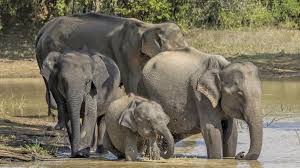Context:
Elephants are known for their complex communication, using a variety of vocal sounds to stay connected within their herds. While most studies have focused on African elephants, a recent study on Asian elephants provides new insights into their vocalizations, especially their iconic trumpeting sounds.
Key Findings:
-
- Four Primary Vocalizations: Asian elephants use trumpets, roars, rumbles, and chirps to communicate, with both high and low-frequency sounds conveying different messages.
- Trumpets Are Multifunctional: Previously believed to be mainly for signaling threats, trumpeting is now found to be used in social interactions, play, and emotional expressions as well.
- Combination Calls: Researchers identified new combination calls, such as the roar-rumble, which likely helps maintain contact and signal disturbances within the group.
- Four Primary Vocalizations: Asian elephants use trumpets, roars, rumbles, and chirps to communicate, with both high and low-frequency sounds conveying different messages.
Age-Based Vocal Variations:
-
- Younger elephants produce higher-pitched calls to establish their presence.
- Older elephants use deeper, lower-pitched calls, likely due to body size and vocal mechanism changes.
- Younger elephants produce higher-pitched calls to establish their presence.

About Asian Elephants
-
- Largest land mammal in Asia, found across 13 countries in South and Southeast Asia.
- Habitat: Lives in dry and wet forests, as well as grasslands.
- Largest land mammal in Asia, found across 13 countries in South and Southeast Asia.
Social Structure:
-
- Highly sociable, forming groups of 6-7 related females led by a matriarch.
- Herds in Asia are smaller than African savannah elephant herds.
- Highly sociable, forming groups of 6-7 related females led by a matriarch.
Diet & Water Needs:
-
- Spend two-thirds of their day feeding on grasses, tree bark, roots, leaves, and stems.
- Need to drink water daily, staying close to freshwater sources.
- Conservation Status of Elephants & India’s Role
- Legal Protection: Listed in Schedule I of the Wildlife Protection Act (1972) and designated as India’s National Heritage Icon.
- Spend two-thirds of their day feeding on grasses, tree bark, roots, leaves, and stems.
Population in India:
-
- India holds ~60% of the global Asian elephant population.
- Largest populations: Karnataka (6,049 elephants), Assam (5,719), Kerala (3,054) (2017 Census).
- India holds ~60% of the global Asian elephant population.
Global Conservation Efforts:
IUCN Red List Status: Endangered.
World Elephant Day (August 12): Raises awareness; 2023 theme: "Ending the Illegal Wildlife Trade."







